 Image search results - "gifu" Image search results - "gifu" |

Bird's eye view of Shirakawa-go from Ogimachi Castle ruins.
|
|

Side view of Wada-ke House
|
|

Shirakawa-go is also a National Important Traditional Townscape Preservation District (重要伝統的建造物群保存地区).
|
|

Path to Wada House entrance
|
|

Close-up of Ogimachi
|
|

Main house on left and latrine on right with large vats to gather fertilizer.
|
|
|

Main house with a recently rethatched roof, making it look very smooth.
|
|

Sekigahara saw one of Japan's most pivotal battles on Oct. 21, 1600 (Sept. 15 of Keicho 5) between Tokugawa Ieyasu's Eastern Forces and Toyotomi Hideyoshi loyalist Ishida Mitsunari's Western Forces. Ieyasu's victory in the Battle of Sekigahara sealed Japan's historical fate for the next 250 years. The former battlefield is dotted with monuments indicating the positions of various warlords during the battle.
This photo shows Mt. Momokubari where Tokugawa Ieyasu first set up his base camp for the Battle of Sekigahara. It is next to busy Route 21. A short distance east of Sekigahara Station. The former Sekigahara battlefield has numerous monuments.
|
|

Banners and a monument mark the spot on Mt. Momokubari where Tokugawa Ieyasu's first base camp was established during the Battle of Sekigahara on Sept. 15, 1600.
|
|

Ieyasu and his troops were here from about 6 am to 10 am on the day of the Sekigahara battle. He later moved closer to the front line as the battle was going his way. This is a National Historic Place. 桃配山 徳川家康最初陣跡
|
|

Steps going up to Tokugawa Ieyasu's first base camp at Momokubari during the Battle of Sekigahara on Oct. 21, 1600 (Sept. 15 of Keicho 5). Today it's just a small hill. The highway seemed to have cut through most of it.
|
|

Steps going up to Tokugawa Ieyasu's first base camp during the Battle of Sekigahara.
|
|

At the top, see the two large rocks which served as a table and bench for Ieyasu. 家康の腰掛岩と机石
|
|

Monuments marking Tokugawa Ieyasu's first base camp during the Battle of Sekigahara. The banners have the Tokugawa family crest.
|
|

View of the Sekigahara battlefield from Tokugawa Ieyasu's first base camp at Momokubari.
|
|

Monument marking Tokugawa Ieyasu's first base camp during the Battle of Sekigahara.
|
|

Another smaller monument marking Tokugawa Ieyasu's first base camp during the Battle of Sekigahara.
|
|

Sign explaining that the two rocks below were said to be used as a bench and table for Ieyasu.
|
|

Behind the monuments is a trail probably used by Ieyasu's troops on Mt. Momokubari-yama.
|
|
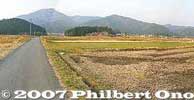
Panoramic view of where the Battle of Sekigahara started. Most battle monuments are within walking distance from the train station, but they are numerous and spread over a wide area.The battle started at the foot of the hill on the left of the road. The small hill on the right was where Shimazu Yoshihiro was stationed. Mt. Ibuki is in the background in the middle.
|
|

Shirakawa-go 白川郷
|
|

Wada House, Shirakawa-go
|
|

The battle started at the foot of the hill on the left of the road. The small hill on the right was where Shimazu Yoshihiro was stationed. Mt. Ibuki is in the background in the middle.
|
|
|
|
|

Path to the Kaisenchi or site where the battle started, at the foot of the hill straight ahead. 開戦地
|
|
|

Gable openings let light and air come through the attic to foster silkworms.
|
|

Banners mark the site where the battle started.
|
|

A small stream beside the house helps to melt the snow falling off the roof.
|
|
|

Monument marking the site where the Sekigahara battle started. 開戦地
|
|
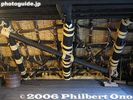
Underside of roof made of an A-frame truss structure
|
|

The thatched roof is replaced every 30 years. Every spring, 6 or 7 thatched roofs are replaced in Shirakawa-go.
|
|

Monument marking the site where the Sekigahara battle started at 8 am on Sept. 15, 1600 (Oct. 21 Western calendar) with Ii Naomasa firing upon Ukita Hideie.
|
|

Sekigahara Stalactite Cavern parking lot. The blue-roof building is a souvenir shop and restaurant.
|
|

Entrance to Sekigahara Warland
|
|

The old JR Takayama Station. This building has been replaced by a new one. 高山駅
|
|
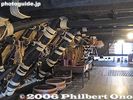
The bottom ends of these beams are pegged into a point (komajiri) resting on another cross beam. Wada House, Shirakawa-go
|
|

Gate to Takayama Jinya
|
|

It costs several million yen and a small army of workers to replace the thatch. The cost is subsidized by the town, prefecture, and national government.
|
|

Where silkworms were raised to make silk cocoons.
|
|

Banner with Ukita Hideie's crest.
|
|

Entrance to cavern.
|
|

Battle Museum 合戦資料館
|
|

JR Takayama Station
|
|

Entrance to Takayama Jinya. A Jinya was a regional government office during the Edo Period. The Tokugawa government dispatched magistrates to administer the region. About 60 jinya existed and only this one survives.
|
|
|
|

Path to Konishi Yukinaga's station, near where the battle started.
|
|
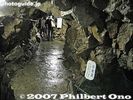
Inside cavern.
|
|

Inside museum with a map of the battle
|
|

Turnstile at JR Takayama Station
|
|

Slats on the attic floor to enable smoke and soot from the hearth to reach the attic.
|
|

For 176 years or 25 generations, the building housed government administrators, accountants (rice tax collectors), and the police.
|
|
|
|
|

Monument for Konishi Yukinaga's station. 小西 行長陣跡
|
|
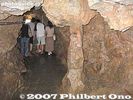
Height of the cavern is barely enough for an adult to walk througgh.
|
|

Warland path
|
|

Waiting room at JR Takayama Station
|
|

Straw rope tie the large beams to form a truss for the roof.
|
|
|

Shirakawa-go 白川郷
|
|

Monument for Konishi Yukinaga's station. 小西 行長陣跡
|
|

Paleozoic fossil
|
|

Yamauchi Kazutoyo
|
|

Another rope made of a crushed tree branch to tie smaller beams. It tightens as it dries.
|
|

Magistrate's (governor) office 御役所
|
|

JR Takayama Station
|
|
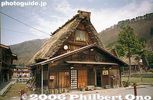
Photo gallery
|
|

View of Administrator's office from the veranda
|
|

Monument for Konishi Yukinaga's station. 小西 行長陣跡
|
|

The cavern is 518 meters long, taking 20 min. to walk it.
|
|
|
|

JR Takayama Station
|
|
|

Area around Konishi Yukinaga's position.
|
|

There are no stairs so you can even take a baby stroller.
|
|
|
|

JR Takayama Station, tourist info office on left.
|
|
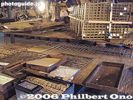
Implements to raise silkworms.
|
|

Restaurant
|
|
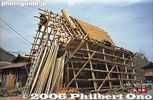
Rethatching a small storehouse.
|
|

Site where the battle started and Mt. Matsuo in the background.
|
|
|

Matchlock guns
|
|

Many attractions are within walking distance from JR Takayama Station.
|
|
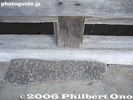
Foundation and pillars rest on stones. The beam is shaped to fit the stone.
|
|

The main building was built in 1816.
|
|
|
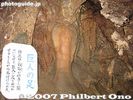
Giant's Leg 巨人の足
|
|

Kobayakawa Hideaki on Mt. Matsuo who turned against Ishida Mitsunari and helped Ieyasu win the battle.
|
|

Bus terminal for Nohi Bus
|
|
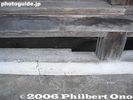
Two foundation beams interlock.
|
|
|
|
|
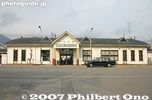
JR Sekigahara Station on the Tokaido Line 東海道線 関ヶ原駅
|
|
|
|
|
|

Tourist info office
|
|

Thatch repair work.
|
|

Old Sekigahara Station in the 1980s.
|
|
|

Mt. Sasaoyama, Ishida Mitsunari's base camp, as seen from the final battlefield. 笹尾山
|
|

JR Sekigahara Station platform
|
|
|
|
|

Shopping street
|
|
|
|
|

Foot of Mt. Sasaoyama, Ishida Mitsunari's base camp. 笹尾山 石田三成陣跡
|
|

JR Sekigahara Station platform
|
|
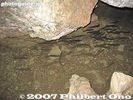
Rainbow trout in the clear (and cold) spring waters.
|
|
|
|

Miyagawa River 宮川
|
|
|
|
|
|

Foot of Mt. Sasao, Ishida Mitsunari's base camp. 笹尾山 石田三成陣跡
|
|

Battle of Sekigahara signboard at Sekigahara Station
|
|

Cavern exit
|
|
|
|

Nakahashi Bridge over Miyagawa River 宮川に掛かる中橋
|
|
|
|

Defensive barriers on Mt. Sasaoyama, Ishida Mitsunari's base camp. 笹尾山 石田三成陣跡
|
|

Battle of Sekigahara signboard at Sekigahara Station, Eastern Forces
|
|

Tamakurabe Clear Spring 日本武尊ゆかりの泉「玉倉部の清水」
|
|

Ishida Mitsunari on Mt. Sasaoyama
|
|

Nakahashi Bridge. During the Takayama Festival, ornate floats cross this bridge. 宮川に掛かる中橋
|
|
|

Battle of Sekigahara signboard at Sekigahara Station
|
|

Tamakurabe Clear Spring was where Yamato Takeru-no-Mikoto got cured by drinking the water after encountering poison mist on Mt. Ibuki.
|
|

Ishida Mitsunari on Mt. Sasaoyama
|
|

Nakahashi Bridge and pine tree
|
|
|
|
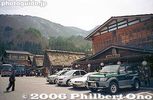
Tourist Information Office in the center of town.
|
|
|

Battle of Sekigahara signboard at Sekigahara Station, Western Forces
|
|

Tamakurabe Clear Spring
|
|

Hand-to-hand combat
|
|
|
|
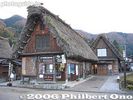
Tourist Information Office
|
|
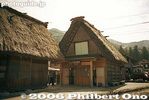
Restroom behind the Tourist Information Office
|
|

Ishida Mitsunari's banner with his family crest.
|
|

Heads of the enemy
|
|

Nakahashi Bridge
|
|
|
|
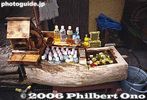
Cooling system
|
|
|

Evidence of victory
|
|

Nakahashi Bridge
|
|
|

Barriers and steps looking down the slope.
|
|

Tokugawa Ieyasu at his base camp
|
|
|
|
|

Parking lot along the main road through the village.
|
|

Steps up to the top of Mt. Sasaoyama.
|
|

Tokugawa Ieyasu inspecting the head of his enemies at his base camp
|
|
|
|

Deai Bridge crossing the Shokawa River.
|
|
|
|

Lookout deck on Mt. Sasao. 笹尾山
|
|

Central Sekigahara town
|
|

Tokugawa allies at his base camp
|
|

Former Takayama-cho Town Hall 旧高山町役場
|
|

Magistrate's living quarters 居宅(嵐山の間)
|
|

Mt. Sasaoyama and stone marker. 笹尾山
|
|

Site of Fuwa-no-seki Gate (no entry) 不破関
|
|
|
|

Former Takayama-cho Town Hall 旧高山町役場
|
|
|

Deai Bridge
|
|

Mt. Sasaoyama and stone monument marking Ishida Mitsunari's base camp.
|
|

Site of Fuwa-no-seki Gate 不破関
|
|

Sekigahara Warland
|
|

Former Takayama-cho Town Hall 旧高山町役場
|
|
|
|

Shokawa River
|
|
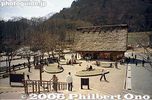
Tourist Info Office near the bus stop.
|
|

Mt. Sasaoyama and stone monument marking Ishida Mitsunari's base camp.
|
|

Site of Fuwa-no-seki Gate 不破関
|
|

Memorial for the fallen warriors at the Battle of Sekigahara
|
|

Storehouse for a Takayama Festival float
|
|
|
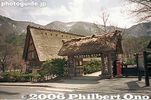
Entrance to the Gassho-zukuri Minka-en outdoor museum.
|
|
|

Fuwa-no-seki Museum 不破関資料館
|
|

Memorial for the fallen warriors at the Battle of Sekigahara, built in 2000, the 400th anniversary.
|
|

Sanno-machi Suji is in Takayama's National Important Traditional Townscape Preservation District (重要伝統的建造物群保存地区).
|
|
|

Gassho-zukuri Minka-en outdoor museum
|
|

Top of Mt. Sasaoyama
|
|

Inside Fuwa-no-seki Museum 不破関資料館
|
|
|

This area is also a National Important Traditional Townscape Preservation District (重要伝統的建造物群保存地区).
|
|

Gassho-zukuri Minka-en outdoor museum
|
|
|
|

Top of Mt. Sasaoyama and stone monument
|
|

Fuwa-no-seki Museum's model of an ancient warrior
|
|
|

Hiroshige's woodblock print of Sekigahara from his Kisokaido series.
|
|
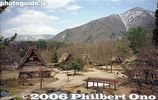
Gassho-zukuri minka houses slated for destruction were moved to this outdoor museum and saved.
|
|

Bath area
|
|

Lookout deck with a bird's eye view of the battlefield.
|
|
|
|

Beckoning cat
|
|
|

Toilet
|
|

Map on lookout deck.
|
|
|
|

Kitchen
|
|

Sekigahara Battlefield, now occupied mainly by rice paddies, a school, and homes. 関ヶ原古戦場
|
|
|
|

Sekigahara Battlefield and Mt. Matsuo 関ヶ原古戦場
|
|
|
|
|
|

Hachiman Shrine
|
|

Fire hydrant
|
|

Large Hall (Dai-hiroma)
|
|

Monument for the final battle, about 1 km in front of Mt. Sasaoyama, where the fighting was the fiercest. 決戦地The left banner has the Ishida Mitsunari's crest and the right banner has the Tokugawa crest.
|
|

Monumental tree next to Hachiman Shrine
|
|

Large Hall (Dai-hiroma) where ceremonies and meetings were held. It could also be partitioned into three rooms. Total area is 48 tatami mats. 大広間
|
|

Manhole in Shirakawa-go.
|
|
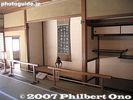
Tokonoma alcove
|
|

Monument for the final battle. By 1 pm, Ishida's Western Forces fell apart, and Ishida fled the scene at 2 pm. 決戦地
|
|

Monumental tree
|
|

Shirakawa Village Office
|
|
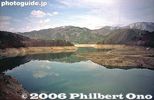
Dam reservoir
|
|
|

Battlefield as seen from the final battle site. Thousands died here. The battlefield is a small plain surrounded by hills and mountains.
|
|

Mihoro Dam, made only of rocks and clay. 131 meters high, 405 meters long.
|
|
|

Tokugawa Ieyasu's Final Base Camp at Jinbano 陣場野 徳川家康最後陣跡
|
|
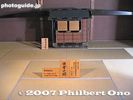
Palanquin
|
|

Tokugawa Ieyasu's Final Base Camp at Jinbano. At 10 am, he moved here from Mt. Momokubari to be closer to the front line. 陣場野 徳川家康最後陣跡
|
|
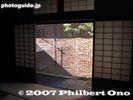
Bamboo screen
|
|

Tokugawa Ieyasu's Final Base Camp at Jinbano 陣場野 徳川家康最後陣跡
|
|
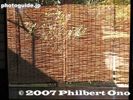
Bamboo screen
|
|

Illustration of Tokugawa Ieyasu's Final Base Camp where he inspected the heads of his defeated enemies.
|
|

Inside Tokugawa Ieyasu's Final Base Camp
|
|

Torture room 吟味所・御白洲
|
|
| 2983 files on 12 page(s) |
1 |
 |
 |
 |
 |
|